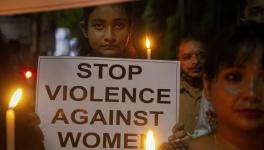India Has Highest Suicide Rate in Southeast Asian Region, Says Study

India had the highest suicide rate in the Southeast Asian region in 2016, according to a recent report by the World Health Organisation (WHO). India has, for the last three years, not made public the official statistics which map the number and causes of suicides across the country, hindering suicide prevention strategies in the country.
According to the World Health Statistics 2019 published by WHO, India’s suicide rate stood at 17.8 suicides per 1,00,000 people in 2016, much higher than the global suicide rate of 10.5. The report presented suicide rates for countries and regions using data from the WHO Global Health Estimates for 2016. According to the data, there were 2,15,872 suicides in the country. This number is even higher, according to a study published in The Lancet. The study put the number of suicide deaths at 2,30,314. Suicide was the leading cause of death in India in 2016 for those aged 15-39 years; 71.2% of the suicide deaths among women and 57.7% among men were in this age group.
Also read: 26,500 Students Committed Suicide Between 2014 And 2016, Govt To Rajya Sabha
The WHO report rated the death registration data quality of each country on a scale of five, where one was the highest score and five the lowest. India’s data was rated four by the report and termed “unusable or unavailable” due to quality issues. Even when India used to publish the data mapping the number of suicide deaths, there was still a huge gap between the National Crime Records Bureau (NCRB) data and WHO estimates. Experts mainly attributed the lower figures in NCRB data to the fact that NCRB draws the data only from First Information Reports (FIRs). NCRB is dependent on data that is under-reported at different levels, in the absence of a robust system to keep a track of the causes of death. The WHO recommended that hospital-based systems and surveys be used to monitor suicide attempts.
Farmers’ Suicides
Upto the year 2016, every year the NCRB used to compile the preceding year’s suicide data in its annual report titled Accidental Deaths and Suicides in India (ADSI). These reports used FIRs as the sources to present the total number of suicide deaths in the country, categorised by cause, means, occupation, educational status, and economic status.
In the years 2014 and 2015, the NCRB included a chapter in the ADSI with data on suicides in the farming sector. These chapters highlighted that five states – Maharashtra, Telangana, Madhya Pradesh, Chhattisgarh, and Karnataka – had accounted for nearly 90% of all farmer suicides in the country in those two years. Prior to 2014, even though the data on suicides was published by NCRB, the government divided the suicides in the farming sector into various categories like suicides by agricultural labourers, by self-employed farmers, and so on, in an attempt to portray the situation in a better light than it was.
Also read: 12,021 Farmers Committed Suicide Under the BJP Regime in Maharashtra
However, two years after the introduction of this new chapter, the NCRB stopped publishing its annual report.
Gender and suicide
The Lancet study analysed gender differentials and state variations in suicide deaths in India, comparing the data from 1990 and 2016. According to the study, an estimated 8,17,000 suicide deaths occurred globally in 2016, accounting for 1.5% of all deaths. Even though only 18% of the world’s population lives in India, the country accounted for 28.19% of all suicide deaths across the world in 2016.
Also read:
The study pointed out that suicide deaths in India increased from 1,64,404 in 1990 to 2,30,314 in 2016, an increase of 40.1%. India’s population was 864 million, that is, 16.4% of the global population in 1990, and accounted for 81,040 (25.3%) of the 3,20,567 global suicide deaths among women and 83,365 (18.7%) of the 4,45,476 global suicide deaths among men. In 2016, India’s population was 1,316 million, that is, 17.8% of the global population, but its contribution to suicides increased to 94,380 (36.6%) of the 2,57,624 global suicide deaths among women and 1,35,934 (24.3%) of the 5,59,523 global suicide deaths among men.
The study said, “The disproportionately high suicide deaths in India are a public health crisis. Suicide ranks as the leading cause of death among young adults in India, and suicides among women need particular attention.” It pointed out that a national suicide prevention strategy is needed as a guide, which then has to be adapted at the state level to take into account the wide variations in trends between the states and the context of each state to reduce the burden of suicide deaths in India.”
Sustainable development goals
With increasing realisation of the public health importance of suicides, the United Nations Sustainable Development Goals (SDGs) include a one-third reduction in suicide death rates (SDR) from 2015 to 2030. According to the study by The Lancet, “If the trends observed up to 2016 continue, the probability of India achieving the SDG SDR reduction target in 2030 is zero.”
It said that the vast majority of the states in India that have 81.3% of the country’s population have less than 10% probability of meeting the SDG 2030 SDR reduction target, three states have a probability of 10.3-15.0%, and six have a probability of 25.1-36.7%. It said, “If the trends of SDR observed up to 2016 continue, India is projected to have an SDR of 15.7 per 1,00,000 population for both sexes combined in 2030. This projected estimate falls short of the SDG target of 12.1 per 1,00,000 population.”
It added, “A comprehensive national suicide prevention strategy that systematically addresses the gender-specific multi-sectoral nature of suicide along with mental health is urgently needed to accelerate the probability of closing the gap towards the SDG target.”
What is the government doing?
According to a study published in the Indian Journal of Psychiatry, the number of people who attempt to die by suicide is 25 times that of the number of those who actually die by suicide every year. It pointed out that in 2016 alone, as many as 5.75 million people attempted to die by suicide in India. It stated, “Attempts to die by suicide can be classified into: (i) severe, leading to incapacity and (ii) non-severe, with full recovery in the short term. As per WHO, in 2016, 17% of the persons who attempted to die by suicide belonged to the severe category, i.e., 9,77,500 persons, and the remaining 83%, i.e., 4.77 million persons belonged to the non-severe category.”
Also read: Why do Armed Forces Personnel Continue to Commit Suicide?
Indian government passed the Mental Healthcare Act (MHCA), 2017, on April 7, 2017, and the Act was enforced on May 29, 2018. This is “an Act to provide for mental healthcare and services for persons with mental illness (who have substantial disorder and whose functioning is grossly impaired) and to protect, promote and fulfil the rights of such mentally ill persons (who have substantial disorder and grossly impaired functioning), during delivery of mental healthcare services and for matters connected therewith or incidental thereto.” Section 115 of this Act decriminalised the attempt to die by suicide, in an attempt to reduce further stress on the victim.
However, even though India has implemented a National Mental Health Programme (NMHP), it has no national-level response system. India does not have a dedicated suicide prevention hotline, unlike most of the developed and developing nations. The three main objectives of NMHP are treatment of mentally ill, rehabilitation, and prevention and promotion of positive mental health. However, neither the objectives nor the strategies involved in the programme talk about any direct measures taken by the government to reduce the SDR.
In the poorer sections of the country, people attempt suicides mainly because of distress due to poverty, unemployment, economic losses, and so on. The government has also not taken any measures to directly address these causes. Focussing on mental health without giving enough important to suicide prevention excludes those sections of the society who do not have any knowledge of, or access to mental healthcare.
The study published in the Indian Journal of Psychiatry said, “Above all, the governments, nongovernmental organisations, health care establishments, professionals, and other related and concerned people need to educate and create awareness among the public at large to fulfil the aims, objectives, and the purpose of enactment of the MHCA 2017 with reference to suicide and attempt to die by suicide.”
Get the latest reports & analysis with people's perspective on Protests, movements & deep analytical videos, discussions of the current affairs in your Telegram app. Subscribe to NewsClick's Telegram channel & get Real-Time updates on stories, as they get published on our website.
























